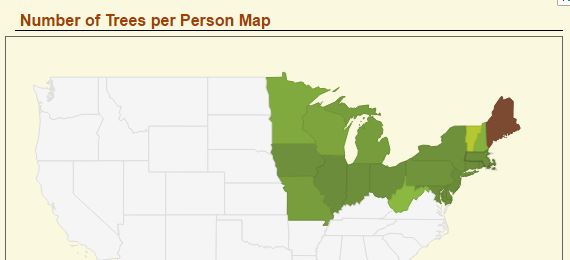The USDA’s Forest Service has launched an intriguing data project that estimates – nay, gives an exact answer – to a question few of us have asked: How many trees does my state have, per person?
For New Hampshire, the answer is 2,857. I wonder if that includes the three I planted this summer (actually, I planted 10 but 7 died in the drought).
Of course this is an estimate, made from total acres of forested land and estimates of tree density based on species and age for each state, and could be off by an order of magnitude depending on your definition of tree. You can check the interactive display here.
Still, it’s interesting, especially associated data. For example, about two-thirds of New Hampshire’s trees are relatively bunched in age – between 41 and 80 years old, a reflection of the way we stopped farming after World War II, and all those plowed fields started regrowing at the same time.
In Maine, which is by far the region’s forest leader partly because of size and partly because about a quarter of it is private land, mostly owned by timber companies, things are different: About half are in the 41-to-80 age group while far more are very young (under 20) and very old (over 100). Vermont’s tree-age spread is similar to New Hampshire’s, but in Massachusetts almost three quarters of trees are 41-to-80, a sign of how much more developed the state is.
The list covers the whole Northeast. New Jersey, if you were wondering, has 117 trees per person. But they’re really tough trees.


 Return to the Concord Monitor
Return to the Concord Monitor
My brother has counted and measured all the trees in the 50 acre forest he lives in.
More than 10,000.
Wow – your brother is a patient man!